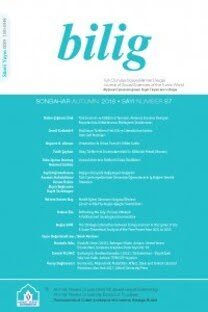A Proposal for the Classification of Objects
Bu yazının başlıca amacı, özneye veriliş tarzları bakımından, olasıtüm nesnelerin bir sınıflamasını yapmaktır. Ne tarzda olursa olsun bir nes-ne, ya benim aklımın, zihnimin, belleğimin, bilincimin, ruhumun veya ha-yal gücümün bir nesnesidir. Fiziksel bir şey karşımızda olduğu zaman, on-dan elde ettiğimiz şeye "görü" diyoruz. Bize duyarlığın yalnızca bir biçi-miyle (görme ile) verilen fiziksel bir şeyin bu nesne türüne "görü nesnesi" adını veriyoruz. Bizzat tanık olmadığım, gazete, TV gibi medya araçlarıyla bana verilen, fiziksel bir şeyin, herhangi bir olayın görüntüsü, iki boyutlu bir yüzeyde bana yine duyarlıkla verilir. Ben bu tür bir şeyin kendisini de-ğil, görüntüsünü görüyorum. Tüm görüntü teknikleriyle verilen bu türü "görüntü nesnesi" olarak adlandırıyoruz. Gerek kendisinden görüsünü edindiğim fiziksel şey, gerekse görüntü, karşımda olmadığı zaman, onlarızihnimde canlandırdığımda, elde ettiğim tasarıma "zihinsel nesne" diyoruz. Bedenimin herhangi bir yerinden aldığım, örneğin bir ağrı duyumunu ve-ya ruhumdaki, örneğin bir sevinç duygusunu, hiçbir perspektif altında ol-maksızın olduğu gibi duyarım. Bilincimle ve ruhumla algıladığım bu nesne türünü "psikolojik nesne" olarak adlandırıyoruz. Zihin ya da anlama yetisi, öznenin dışındaki şeylerin görülerinden tasarımlar ve kavramlar edinirken akıl, kendi kavramlarını, nesnelerini yaratır. Onlar, herhangi bir şeyin gö-rüsü, duyumu değildir; özneye duyarlıkla verilmezler. Tüm matematiksel-mantıksal nesneler-kavramlar, bunlarla yapılan işlemler, tanımlar, ispatlar, kurgular, bu türe girer. Akıl nesnesi ile görü nesnesinin bir çeşit karışımıolan bir nesne türünden daha söz etmek istiyoruz. Bilimde ilkeler olarak bulunan bu tür nesneleri, aklın deneye, yani görü nesnesine yaptığı katkıy-la elde ettiği, başka bir deyişle, duyarlığa aklın katılmasıyla, aklın görü nesnesinden çıkardığı nesne anlamında kısaca "çıkarım nesnesi" diye ad-landırıyoruz. Sınıflamamızın son bir türü olarak "hayal gücü nesnesi"nden söz etmek istiyoruz. Bu nesneler, öznenin, doğrudan doğruya, ne kendin-de (ruh ve bedeninde) bulduğu bir etkinin ne de kendi dışındaki bir şeyin görü ve tasarımının nesnesi olmayıp, onların yardımıyla hayal gücü saye-sinde kurguladığı nesnelerdir. Hayal gücü nesnesi, her tarzıyla daima göz önüne getirilebilen bir nesnedir.
Nesnelerin Bölümlenmesi Hakkında Bir Öneri
The main purpose of this paper is to make a classification of all probable objects from the standpoint of their appointment to a subject. An object of any kind is an object of my reason, my mind, my memory, my consciousness, my soul or my imagination. When a physical thing is in front of us we call that thing we obtain from it "intuition". We call this object type of a physical thing that is provided by a single form of sensitiveness (by means of sight) an object of intuition. In the case of an event I do not witness personally but which is provided by means of media instruments such as newspapers or TV, it is also sensitiveness which provides me with the appearance of a physical thing on a twodimensional surface. We call this type, provided by all visual techniques, an object of appearance. When neither the physical thing from which I obtain the intuition nor its appearance is in front of me and when, instead, I create them in my mind, the representation I obtain we call a mental object. I feel a sense of pain that I receive from any part of my body or a sensation of joy in my soul as they are, not from any perspective. We call this type of object, perceived by the consciousness and the soul, a psychological object. The intellect or mind acquires representations and concepts from things outside the subject; reason creates its own concepts and objects. All mathematical-logical objects-concepts, operations made by them, definitions, demonstrations and constructions are of objects of reason. Here, we shall talk about yet another kind of object that is a combination of object of reason and object of intuition. These objects, which exist in the sciences as principles, we call objects of inference, in the sense that they are objects which reason infers from objects of intuition or, in other words, objects created by reason through inference. We shall now speak of objects of imagination as a last kind in our classification. These objects are not objects of intuition or representations of something that the subject either found directly in itself (in its soul and/or body) or in something outside of itself. The object of imagination is an object that may always be visualized in all ways.
___
Aristotle (1957). On the soul. With an English translation by W. S. Hett. Cambridge, Massachusetts: Harvard University Press.
Husserl, Edmund (1952). Ideas General Introduction to Pure Phenomenology. Translated by W. R. Boyce Gibson. London: George Allen & Unwin LTD.
Kant, Immanuel (1998). Critique of Pure Reason. Translated and Edited by Paul Guyer and Allen W. Wood. Cambridge University Press.
Russell, Bertrand (1912). The Problems of Philosophy. London: Oxford University Press.
Wittgenstein, Ludwig (1997). Philosophical Investigations. Translated by G. E. M. Anscombe. Blackwell Publishers Ltd.
(1980). Remarks on the Philosophy of Psychology. Volume I. Edited by G. E. M. Anscombe and G. H. Von Wright and translated by G. E. M. Anscombe. Volume II. Edited by G. H. Von Wright and Heikki Nyman, and translated by C. G. Luckhardt and M. A. E. Aue, Basil Blackwell Oxford.
(1997). The Blue and Brown Book. Blackwell Publishers Ltd.
